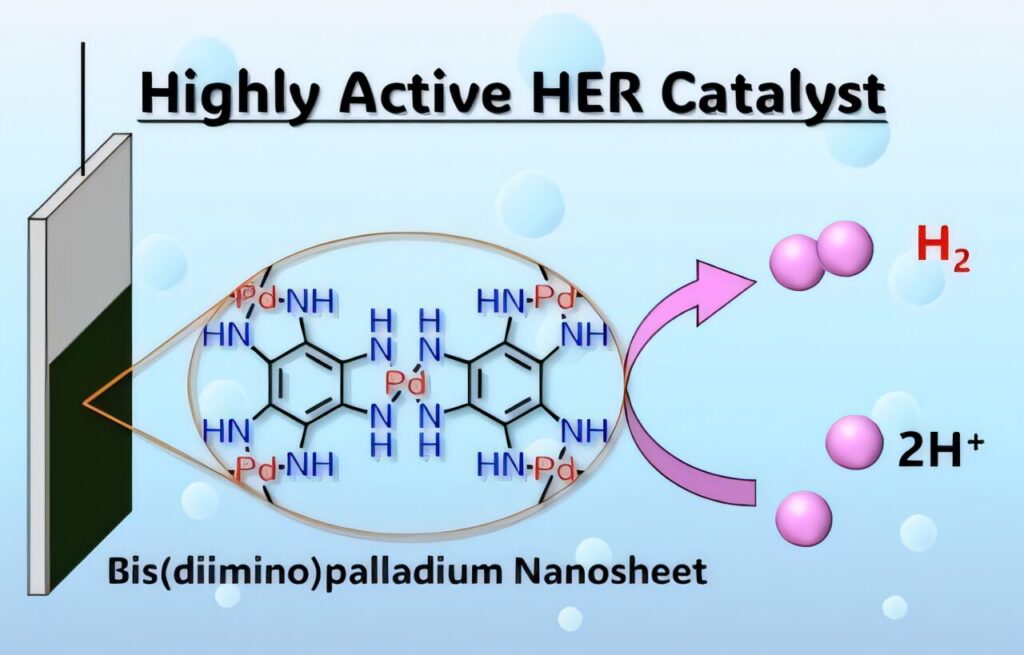Hydrogen energy is emerging as a key driver of a clean, sustainable future, offering a zero-emission alternative to fossil fuels. Although it is promising, the large-scale production of hydrogen relies heavily on expensive platinum-based catalysts, and hence affordability remains a major challenge for the industry.
To surpass this, researchers from the Tokyo University of Science (TUS) have developed a novel hydrogen evolution catalyst, bis(diimino)palladium coordination nanosheets (PdDI), that offers platinum-like efficiency at a fraction of the cost. Their study was published in Chemistry—A European Journal.
The study was led by Dr. Hiroaki Maeda and Professor Hiroshi Nishihara from TUS in collaboration with high-profile researchers from the University of Tokyo, Japan Synchrotron Radiation Research Institute, Kyoto Institute of Technology, RIKEN SPring-8 Center, and the National Institute for Materials Science, Japan.
The discovery marks a breakthrough in the hydrogen evolution reaction (HER) technology, which is a key process in green hydrogen energy generation. HER occurs in the process of electrolytic splitting of water for the generation of hydrogen. The HER catalyst electrodes, traditionally made of platinum, facilitate the conversion of nascent hydrogen ([H])―generated at the electrode surface during water splitting―into hydrogen gas (H₂).
Although platinum (Pt) as a HER catalyst is highly effective, its scarcity and high cost significantly increase manufacturing expenses, limiting its large-scale application.
Using a simple synthesis process and limited amounts of precious metals, the research team offered a highly efficient alternative for Pt catalysts. The team fabricated palladium-based nanosheets that could maximize catalytic activity while minimizing metal usage, drastically lowering the costs associated with H₂ production.
“Developing efficient HER electrocatalysts is key to sustainable H₂ production. Bis(diimino)metal coordination nanosheets, with their high conductivity, large surface area, and efficient electron transfer, are promising candidates,” says lead researcher, Dr. Maeda. “Additionally, their sparse metal arrangement reduces material usage. Here, we have successfully developed these nanosheets using palladium metal.”
The team developed PdDI nanosheets (C-PdDI and E-PdDI) using two different methods: gas-liquid interfacial synthesis and electrochemical oxidation respectively. After undergoing the activation, the E-PdDI sheets exhibited a low overpotential of 34 mV as well as platinum’s overpotential of 35 mV, which meant that very little extra energy was required to drive the hydrogen production.
The exchange current density of 2.1 mA/cm² also matched the platinum’s catalytic performance. The results therefore place E-PdDI among the most efficient HER catalysts developed to date, making it a promising low-cost alternative to platinum.
One of the critical aspects of any catalyst is its long-term stability. These PdDI nanosheets demonstrated excellent durability, remaining intact after 12 hours in acidic conditions, confirming their suitability for real-world hydrogen production systems. “Our research brings us one step closer to making H₂ production more affordable and sustainable, a crucial step in achieving a clean energy future,” explains Dr. Maeda.
Furthermore, by minimizing the reliance on scarce and costly platinum, PdDI nanosheets align with the United Nations’ Sustainable Development Goals (SDGs): SDG 7―promoting affordable and clean energy, SDG 9―industry, innovation, and infrastructure.
The implications of this study extend beyond laboratory experiments. The scalability, enhanced activity, and cost-effectiveness of PdDI nanosheets make them highly attractive for industrial hydrogen production, hydrogen fuel cells, and large-scale energy storage systems.
Replacing platinum-based catalysts with PdDI could reduce mining-related emissions, accelerating the transition to a sustainable hydrogen economy. Also, the density of palladium atoms is 10 times less than Pt atoms, reducing the dependency on precious Pt metals, and approaching the cost-effective production of electrodes. The replacement of Pt with PdDI nanosheets is expected to produce great outcomes in automobiles, hydrogen production, and electrode-supplying industries.
As research progresses, the team at TUS aims to further optimize PdDI nanosheets for commercialization, contributing to the development of an environmentally friendly hydrogen society.


